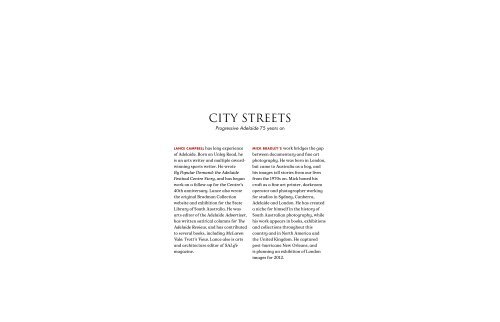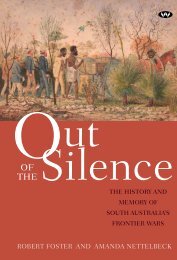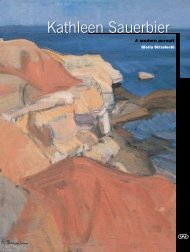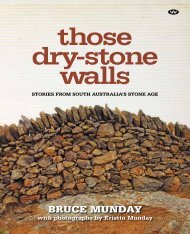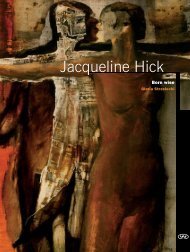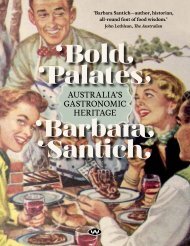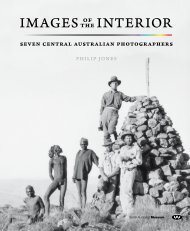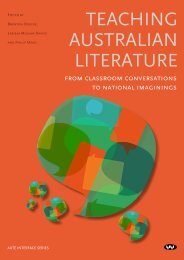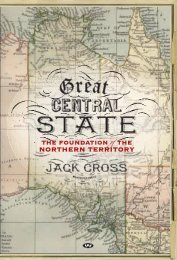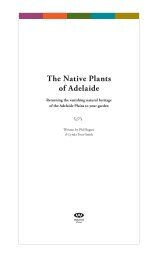City Streets: Progressive Adelaide 75 years - Wakefield Press
City Streets: Progressive Adelaide 75 years - Wakefield Press
City Streets: Progressive Adelaide 75 years - Wakefield Press
You also want an ePaper? Increase the reach of your titles
YUMPU automatically turns print PDFs into web optimized ePapers that Google loves.
<strong>City</strong> streets<br />
<strong>Progressive</strong> <strong>Adelaide</strong> <strong>75</strong> <strong>years</strong> on<br />
Lance campbeLL has long experience<br />
of <strong>Adelaide</strong>. Born on Unley Road, he<br />
is an arts writer and multiple awardwinning<br />
sports writer. He wrote<br />
By Popular Demand: the <strong>Adelaide</strong><br />
Festival Centre Story, and has begun<br />
work on a follow-up for the Centre’s<br />
40th anniversary. Lance also wrote<br />
the original Bradman Collection<br />
website and exhibition for the State<br />
Library of South Australia. He was<br />
arts editor of the <strong>Adelaide</strong> Advertiser,<br />
has written satirical columns for The<br />
<strong>Adelaide</strong> Review, and has contributed<br />
to several books, including McLaren<br />
Vale: Trott’s View. Lance also is arts<br />
and architecture editor of SALife<br />
magazine.<br />
mick bradLey’s work bridges the gap<br />
between documentary and fine art<br />
photography. He was born in London,<br />
but came to Australia as a boy, and<br />
his images tell stories from our lives<br />
from the 1970s on. Mick honed his<br />
craft as a fine art printer, darkroom<br />
operator and photographer working<br />
for studios in Sydney, Canberra,<br />
<strong>Adelaide</strong> and London. He has created<br />
a niche for himself in the history of<br />
South Australian photography, while<br />
his work appears in books, exhibitions<br />
and collections throughout this<br />
country and in North America and<br />
the United Kingdom. He captured<br />
post-hurricane New Orleans, and<br />
is planning an exhibition of London<br />
images for 2012.
<strong>City</strong> <strong>Streets</strong><br />
<strong>Progressive</strong> AdelAide <strong>75</strong> <strong>years</strong> on<br />
Lance Campbell and Mick Bradley
<strong>Wakefield</strong> <strong>Press</strong><br />
1 The Parade West, Kent Town, South Australia 5067<br />
www.wakefieldpress.com.au<br />
First published in association with <strong>Adelaide</strong> <strong>City</strong> Council, 2012<br />
New text copyright © Lance Campbell, 2012<br />
New photographs copyright © Mick Bradley, 2012<br />
All rights reserved. This book is copyright. Apart from any fair dealing for the purposes of private study, research,<br />
criticism or review, as permitted under the Copyright Act, no part may be reproduced without written permission.<br />
Enquiries should be addressed to the publisher.<br />
Designed by Liz Nicholson, designBITE<br />
Photoshop work and image retouching by Graphic Print Group<br />
Printed in China through Red Planet Print Management<br />
National Library of Australia Cataloguing-in-Publication entry<br />
Author: Campbell, Lance, 1949– .<br />
Title: <strong>City</strong> <strong>Streets</strong>: <strong>Progressive</strong> <strong>Adelaide</strong> <strong>75</strong> <strong>years</strong> on / Lance Campbell and Mick Bradley.<br />
ISBN: 978 1 86254 920 3 (hbk.).<br />
Subjects: <strong>Adelaide</strong> (S. Aust.) – History. <strong>Adelaide</strong> (S. Aust.) – Buildings, structures, etc.<br />
Other Authors/Contributors: Bradley, Mick.<br />
Dewey Number: 994.231
Foreword<br />
<strong>City</strong> <strong>Streets</strong> provides a unique snapshot of our city at two points in time. The first shows <strong>Adelaide</strong> in 1936,<br />
the centenary of European settlement of South Australia, and the second <strong>75</strong> <strong>years</strong> on.<br />
The images provide a fantastic insight into how <strong>Adelaide</strong> has grown from virtually a country town into a<br />
place of international standing, recently acknowledged as Australia’s most liveable city.<br />
The streetscapes in this book are fascinating. Some appear virtually unchanged, while others have lost<br />
buildings now viewed as iconic, such as the South Australian Hotel.<br />
<strong>City</strong> <strong>Streets</strong>: <strong>Progressive</strong> <strong>Adelaide</strong> <strong>75</strong> <strong>years</strong> on had its beginnings in the term of <strong>Adelaide</strong> <strong>City</strong> Council<br />
2006–2010, with particular support from Councillor Sandy Wilkinson. I thank the Councillors for<br />
initiating this project, and <strong>Wakefield</strong> <strong>Press</strong> for bringing it to life.<br />
I hope you enjoy this book. It’s an intriguing slice of history.<br />
Stephen Yarwood<br />
Lord Mayor of <strong>Adelaide</strong>
Contents<br />
Introduction 1<br />
King William Street 7<br />
North Terrace 21<br />
Hindley Street 39<br />
Rundle Mall 51<br />
Rundle Street & East End 67<br />
Currie Street 83<br />
Grenfell Street 91<br />
Waymouth Street 103<br />
Pirie Street 111<br />
Gawler Place 121<br />
Flinders & Franklin <strong>Streets</strong> 129<br />
Grote Street 141<br />
Gouger Street 149<br />
Victoria Square 159<br />
From the Heart, Lance Campbell 164<br />
Photograph credits and Acknowledgements 166<br />
Afterword, Timothy Horton, Commissioner for Integrated Design 167
Introduction<br />
In 1936, the centenary year of the former colony of South Australia, printer and newspaperman Gustav<br />
Hermann Baring published <strong>Progressive</strong> <strong>Adelaide</strong>. The big, handsome book was a mighty achievement.<br />
Baring wanted his State to shine on its 100th birthday.<br />
<strong>Progressive</strong> <strong>Adelaide</strong> embraced the capital city and its seaside resorts, along with South Australia’s major<br />
provincial centres. By photographing the city’s street fronts, Baring created a near-perfect record of the<br />
<strong>Adelaide</strong> CBD of the 1930s.<br />
And by financing his book with advertising, he also left us with a profile of the business life of the State as<br />
South Australia carried itself out of the Great Depression.<br />
<strong>Progressive</strong> <strong>Adelaide</strong> is the inspiration for <strong>City</strong> <strong>Streets</strong>. Three-quarters of a century on, the <strong>City</strong> of <strong>Adelaide</strong><br />
and <strong>Wakefield</strong> <strong>Press</strong> recognised the enduring significance and human interest of the first book. Yet simply<br />
reprinting <strong>Progressive</strong> <strong>Adelaide</strong> would have heightened nostalgia, but served no particular purpose.<br />
<strong>Adelaide</strong> is more than its past. There is its present, and its future.<br />
So you hold the second book. <strong>City</strong> <strong>Streets</strong> relives Baring’s pictorial exploration of the city CBD, going to<br />
the same places, taking their photos again and pausing for stories along the way. We also have allowed<br />
ourselves the liberty of extending the range of this book beyond the original’s commercial boundaries into<br />
<strong>Adelaide</strong>’s rich cultural dimension.<br />
As far as we are aware, a book of this scope chronicling two eras of a capital city has never been published<br />
before.<br />
Certain historic buildings in <strong>Progressive</strong> <strong>Adelaide</strong> did not survive to appear here. There will always be a<br />
lesson in that. But <strong>Adelaide</strong> remains a captivating city in its many forms. <strong>City</strong> <strong>Streets</strong> re-interprets the<br />
rich legacy of <strong>Progressive</strong> <strong>Adelaide</strong>. It might just start a trend.<br />
– 1 –
arinG & bradLey<br />
Hermann Baring needed a buckboard<br />
and a black cloth over his head to<br />
photograph <strong>Progressive</strong> <strong>Adelaide</strong>.<br />
Three quarters of a century later,<br />
Mick Bradley used tripod and ladder.<br />
Baring must have worked hard on<br />
Sunday mornings, when everyone else<br />
was at church and the city streets<br />
were clear. He would not have seen<br />
grown men in Hindley Street hide<br />
behind newspapers at the sight of a<br />
Digital SLR. Mick Bradley did.<br />
He would not have observed a<br />
woman remove most of her clothing<br />
and wrap it around Rundle Mall’s<br />
brass pigs to keep them warm in the<br />
middle of winter. Nor did Baring<br />
bump into the singer Cliff Richard<br />
leaving A Class Shoe Repairs.<br />
Bradley did. He spent six months<br />
of a year of his working life walking<br />
the streets of <strong>Adelaide</strong> for this book,<br />
a photographic flaneur. He spent<br />
the other six months up the ladder,<br />
a watcher above the crowd.<br />
There’s a lot of time to think at the<br />
top of a ladder in a big city, waiting<br />
for a bus to move or a light to change.<br />
Baring was a good photographer,<br />
Bradley reasoned, to take all those<br />
pictures in 15 months. Even if he didn’t,<br />
and Les J. Kyte helped him, Bradley<br />
still takes off his hat to Baring.<br />
He didn’t have the traffic lights,<br />
bus shelters, wires, street signs<br />
and roadworks to contend with.<br />
But although the principles of<br />
photography haven’t changed in <strong>75</strong><br />
<strong>years</strong>, the technology has. Baring<br />
had to correct distortions caused by<br />
photographing buildings in narrow<br />
streets “in camera”, each on a single<br />
piece of 4x5 film.<br />
He might have had the latest roll<br />
film camera with movements, such as<br />
a German Linhof Technicka. What he<br />
didn’t have was Photoshop.<br />
For all his skills, some places<br />
defeated Baring. He couldn’t straighten<br />
up the Epworth Building in Pirie<br />
Street, no matter how hard he tried.<br />
Gawler Place was a pain, for both<br />
photographers. No room to move.<br />
Baring couldn’t reach the architecture,<br />
so he shot only the shopfronts. Bradley<br />
photographed everything.<br />
The compensations far outweighed<br />
the complications, however.<br />
Mick Bradley first came to<br />
<strong>Adelaide</strong> from the east in 1961, to<br />
what he saw as “a smaller, more<br />
manageable Sydney, with a much<br />
prettier name”. A year later, when<br />
Bradley was gone again before<br />
returning, the Tavistock Hotel<br />
was torn down for the widening of<br />
Tavistock Street into Frome Street.<br />
Like many South Australians,<br />
Bradley didn’t know that – until he<br />
went to photograph the Tavistock<br />
Hotel. He thanked the gods of building<br />
preservation that the rest of the<br />
beautiful array of South Australiana<br />
heading east along Rundle Street<br />
hadn’t been treated the same<br />
heartless way.<br />
And as a documentary<br />
photographer, Bradley thanked<br />
Baring for keeping a pictorial record<br />
of the Tavistock Hotel, so he could<br />
enjoy imagining it.<br />
Up the ladder, Bradley found<br />
himself scrutinising <strong>Adelaide</strong>’s<br />
buildings more closely than your<br />
average flaneur. He marvelled at the<br />
“extensive, intricate carving and<br />
stonework on these 100-plus-yearold<br />
constructions, the expense the<br />
original settlers were prepared to go<br />
to, their amazing commitment to the<br />
future of the State of South Australia.<br />
“Doing this book has driven home<br />
to me the vision of our forebears, the<br />
trouble they would go to, the love and<br />
care our craftsmen and architects<br />
had, so that their buildings would<br />
stand for a significant time.<br />
“Where people prefer to gather<br />
is where our architecture has been<br />
preserved, like the East End. Some<br />
of the 1970s facades are starting to<br />
peel off. Maybe we’ll find something<br />
worthwhile behind.”<br />
Such reflections might be<br />
interrupted by “Waddaya taking<br />
fodas of?” Or an Asian visitor’s “What<br />
lens you use?” Or on moving the<br />
ladder to the next location, “The boss<br />
said you were coming, told me to look<br />
after ya. Want a drink?”<br />
In his year on the streets, Bradley<br />
shot several thousand photographs<br />
to make up the 800 in this book. As<br />
he took them, his kinship with Baring<br />
grew. “Hermann did an extraordinary<br />
job, to even conceive of the idea. It’s<br />
not a common project. I haven’t seen<br />
it done to any other city.<br />
“Perhaps in another <strong>75</strong> <strong>years</strong>,<br />
this book will resurface and be as<br />
intriguing as Hermann’s is now.”<br />
Late one afternoon in Currie<br />
Street, as Bradley was shooting his<br />
smaller, more manageable Sydney<br />
with a much prettier name, a passerby<br />
with an Irish lilt called to him:<br />
“God bless you for photographin’ the<br />
billdin’s.” He shook Bradley’s hand,<br />
and walked on.<br />
Someone might have said that to<br />
Hermann Baring <strong>75</strong> <strong>years</strong> ago. If not,<br />
someone should have.
<strong>75</strong> <strong>years</strong> on<br />
The State Library of South Australia,<br />
by law, has a copy of the original<br />
<strong>Progressive</strong> <strong>Adelaide</strong> from 1936. The<br />
Baring family has one.<br />
<strong>City</strong> of <strong>Adelaide</strong> senior heritage<br />
architect John Greenshields found<br />
<strong>Progressive</strong> <strong>Adelaide</strong> in the Holdfast<br />
Bay library, which led to a photocopy<br />
for his Council. <strong>Adelaide</strong> <strong>City</strong><br />
Councillor Sandy Wilkinson picked up<br />
an original edition in an <strong>Adelaide</strong> Hills<br />
bookshop.<br />
Wilkinson and Greenshields saw<br />
the heritage value of <strong>Progressive</strong><br />
<strong>Adelaide</strong>. In it, the streetfronts are like<br />
black and white movie stills. So the old<br />
book is, and always will be, a resource<br />
for the repair and restoration of our<br />
historic buildings.<br />
But <strong>Progressive</strong> <strong>Adelaide</strong> was never<br />
meant to be a mere manual. It was a<br />
prestige publication at a prestige time.<br />
From that, the idea began to grow:<br />
let’s do it again.<br />
The plan was to contrast <strong>Adelaide</strong>’s<br />
past with its more complex present.<br />
By presenting specific locations threequarters<br />
of a century apart, the errors<br />
of destruction across the generations<br />
would be there to see. Ideally, in<br />
the next <strong>75</strong> <strong>years</strong> more of our built<br />
heritage would be retained.<br />
Yet <strong>Progressive</strong> <strong>Adelaide</strong> itself<br />
seemed to grow with each fresh look<br />
at it. So, it followed, did this book.<br />
Instead of shooting a selection of<br />
buildings, photographer Mick Bradley<br />
revisited every address in the original.<br />
That meant 1800 images of <strong>Adelaide</strong>’s<br />
CBD eventually appeared on the<br />
computer screen at Graphic Print<br />
Group in Richmond.<br />
For each street section, every<br />
photo had to be “stitched” together<br />
to become one big photo. Baring<br />
used scissors, glue and his own<br />
discriminating sense of location,<br />
direction and proportion. Graphic<br />
Print Group Mac operator Peter<br />
Verheyen used Photoshop.<br />
Even after 30 <strong>years</strong> in the trade,<br />
Verheyen found himself tested.<br />
Bradley would photograph a building<br />
with an awning or a verandah. That<br />
same awning or verandah would<br />
appear in the photo of the building<br />
next door, but with a different<br />
perspective, placed at a different<br />
angle. If not corrected, <strong>Adelaide</strong> would<br />
look like a row of shacks.<br />
The Photoshop trick was to<br />
match the perspectives every time.<br />
Anything in front of a building could<br />
cause problems – those awnings and<br />
verandahs, tables, chairs, cars, people.<br />
Light and season changes had to be<br />
considered, too. The job took hours on<br />
the Mac, then months, and sometimes<br />
it couldn’t be done. So Bradley went<br />
back up his ladder with his camera.<br />
North Terrace heading west and<br />
Rundle Street heading east are on<br />
slopes. If Peter hadn’t straightened<br />
them, both streetscapes would have<br />
wandered down the page and fallen<br />
off. Don’t worry, Baring did exactly<br />
the same thing, his own way.<br />
Verheyen was very glad that his<br />
task was a square city on a grid on a<br />
plain, that it was <strong>Adelaide</strong> not Sydney.<br />
He doubts that most cities, with<br />
their undulations and street-level<br />
idiosyncrasies, could be captured<br />
as <strong>Adelaide</strong> has been captured<br />
here. Baring did, indeed, try to do a<br />
<strong>Progressive</strong> <strong>Adelaide</strong> on Sydney, but<br />
he appears to have retired defeated.<br />
His <strong>Progressive</strong> Sydney of 1938<br />
contains only a fragment of that city’s<br />
CBD. He had better luck further out<br />
with flatter Parramatta.<br />
Designer Liz Nicholson began<br />
her career at the end of the cut and<br />
paste era. She quickly developed an<br />
appreciation of Baring’s bare-hands<br />
achievement while applying the new<br />
technology to rationalise not one, but<br />
two, books. Liz also tracked down<br />
support images from the State Library<br />
of South Australia, the <strong>City</strong> Council<br />
and other sources.<br />
“It was the master of all jigsaw<br />
puzzles to put together, to make it<br />
read well so people can navigate it,”<br />
Liz said. Along the way her eyes were<br />
opened to the enjoyment of “What a<br />
beautiful city we have, with beautiful<br />
buildings still in use.”<br />
Z The photographer and the writer at work, in what<br />
was once the front bar of the Tavistock Hotel.
Pageant of Progress, south australia’s centenary, 1936<br />
– 6 –
King William Street
norTH TerraCe<br />
Former bank oF neW soutH WaLes<br />
(1939–1942)<br />
Lady visitors staying at north Terrace<br />
Hotels are advised that the Toilet salon<br />
of miss eLsie tonkin is the nearest,<br />
and that expert attention is assured in<br />
all branches of ladies hairdressing.<br />
situated at 10 King William street, just<br />
a few doors south of north Terrace,<br />
you are saved the inconvenience of<br />
traversing crowded streets. Permanent<br />
waving a specialty. Phone: C. 2884.<br />
FoWLers Lane<br />
KING WILLIAM STREET (East Side), Between North Terrace and Rundle Mall<br />
– 8 –<br />
F.W. preece & sons,<br />
Booksellers and Librarians.<br />
Importers of foreign books<br />
and periodicals.<br />
beeHive corner buiLdinG (1896)<br />
The Bank of New South Wales building, <strong>Adelaide</strong>’s finest modernist commercial building of its era, was still on the drawing boards in the centenary year. The Beehive Corner, <strong>Adelaide</strong>’s Piccadilly<br />
Circus or Times Square, had been a landmark already for 90 <strong>years</strong>. It took its present liquorice allsorts form in the late 19th century, and became the city’s first picture theatre. Then, like the<br />
chocolates sold there for generations, Beehive Corner was steadily devoured. It was restored 100 <strong>years</strong> after it was built, and just as well. The city would not be what it is without the Beehive Corner,<br />
where <strong>Adelaide</strong> people meet on the widest capital city main street in Australia.<br />
aPoLLo PLaCe<br />
rundLe sTreeT
WaterHouse cHambers, Corner<br />
rundle street, 44 King William street.<br />
m.s. durant, Practical Watchmaker,<br />
does work of the highest class on the<br />
second floor of Waterhouse Chambers.<br />
sHuttLeWortH & LetcHFord, Licensed<br />
Land Brokers, auctioneers and real<br />
estate agents.Waterhouse Chambers.<br />
established 1857.<br />
CLarenCe PLaCe<br />
Gray’s, 56 King William<br />
street. The only complete<br />
store for men. Founded<br />
on the principles of<br />
Truth, style, Quality and<br />
Value—both in Mercery<br />
and Hand-Tailoring.<br />
cHarLes WeLLs & co.,<br />
Chemists, 60 King William<br />
street, Phone: C 4717.<br />
adelaide’s Most Central<br />
Hotel. Hot and cold water<br />
in every room. spacious<br />
Balconies. Moderate Tariff.<br />
noonan’s soutHern<br />
cross HoteL. M.J.<br />
noonan, Managing<br />
director. Phone: C. 563<br />
(2 Lines).<br />
– 9 –<br />
sands &<br />
mcdouGaLL<br />
pty. Ltd., 64<br />
King William<br />
street, Printers,<br />
Manufacturing<br />
stationers.<br />
established 1882.<br />
main & son–cHemists,<br />
66 King William street,<br />
“accuracy”–”service”–<br />
”Quality”. “Mains for<br />
Medicine”.<br />
covent Garden<br />
restaurant and caFe<br />
KING WILLIAM STREET (East Side), between Rundle Mall and Grenfell Street<br />
Former WaterHouse cHambers (1848) sands & mcdouGaLL<br />
buiLdinG (1881, 1933)<br />
s.o. beiLby, shipping<br />
and retail Grocer and<br />
Provision Merchant,<br />
70 King William<br />
street, adelaide (late<br />
Crawford’s). C. 5000.<br />
centraL provision<br />
stores, King William<br />
street, High-Class<br />
Grocers, Provision, and<br />
Tea Merchants. Phone:<br />
C. 1263 (3 lines).<br />
Directly across from the Beehive Corner, the former Waterhouse Chambers has, by South Australian standards, much antiquity. It might not be an attention seeker like its partner at the entrance<br />
to Rundle Mall, but it has stood there since the 1840s, when the famous Burra Burra copper “monster mine” paid for it. <strong>Adelaide</strong> takes the old Waterhouse Chambers for granted. Brought back to its<br />
original limewash, it would reveal itself as a graceful Regency Georgian building. Along the street, tucked in like a book on a bookshelf, the slim volume Sands & McDougall Building, or “Sands and<br />
Mac”, is one of the city’s great survivors. Presumably its minimal ground floor space, and consequent lower rental income, saved the loveable art deco building. In 1948 the Covent Garden Restaurant<br />
and Cafe next door went up in smoke, killing five in the kitchen and provoking a call for more ambulances. A man slid down a drainpipe to safety prompting further calls, this time for fire escapes.<br />
The modernist ex bank building there now contributes to a small yet distinctive “main drag” precinct, often overlooked despite its variety of buildings from different eras.<br />
GrenFeLL sTreeT


